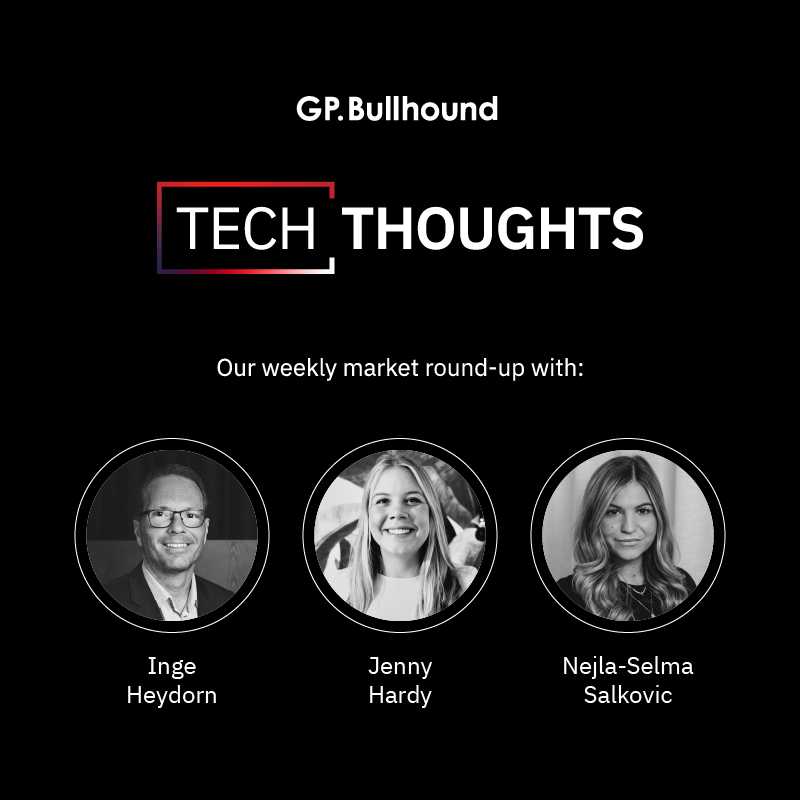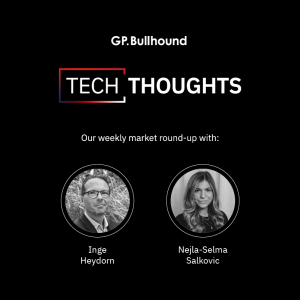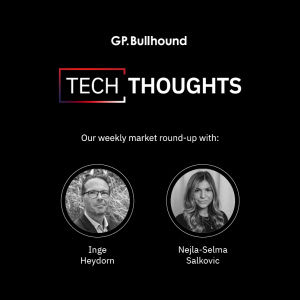Tech Thoughts Newsletter – 10 March 2023.

Market: Market volatility increased this week driven by concerns around startup-lender Silicon Valley Bank. They noted a higher-than-expected “cash burn” from clients, falling deposits and rising costs of capital. Shares fell 60% on Thursday. Although SVB’s customers are predominantly tech start-ups, the contagion read is really around the financial sector, and US banks more broadly saw share price hits, despite the very different asset/liability mix and customer base.
On rising interest rates and “cash burn” as it relates to tech – the companies that are really exposed to interest rate rises are those with leveraged balance sheets. Really the tech sector as a whole – and certainly the companies we own – don’t have leverage – they’re cash rich and cash generative. Most of our portfolio are either paying a dividend or have buyback programs.
There is some impact to tech through discount rates and the resulting multiple and we’ve seen that already deflate the tech sector multiple. The most impacted within tech should be the stocks with more of their value in the terminal – typically the very high growth, highly rated parts of the sector – which are (just mathematically) more sensitive. Our investment philosophy as a team is to focus on companies’ financial productivity and their ability to sustain that over a long period of time given competitive advantages. This in turn leads to a focus on cash flows and return on invested capital of the businesses we own, and their ability to compound those (through reinvestment) over time. That focus typically leads us away from the more interest-rate sensitive parts of the sector.
It’s much quieter on the results front at this stage of the quarter – just a few companies reporting (nothing we own) – but the focus this week has been the comments coming out from companies’ presentations at conferences. We run through our key takes below.
Portfolio: We have not made any major changes to our portfolio this week.
AI continuing to stimulate chip demand – AMD gaining share from Intel with superior performance
- AMD (owned) continues to execute from our perspective and continues to gain share from Intel on the CPU side. Their performance, energy efficiency and therefore total cost of ownership (TCO) advantage makes it a very easy decision to choose them over Intel for hyperscaler x86 workloads.
- What’s interesting for the future product evolution is AMD having both CPU (for low level inference) and GPU (for dense large language model inference) capability, and being able to combine both in the compute of high performance AI workloads.
- Intel on the other hand is without doubt struggling on its process technology, where AMD is benefitting from/piggybacking on TSMC’s leadership.
- Intel (not owned) were also speaking – since their results they’ve cut the dividend by 60% and at the conference they acknowledged the market share loss they’re seeing on the datacentre side, which they don’t expect to stabilise in the short term given the lagging efficiency metrics of their product portfolio.
- Oracle (not owned) reported Q3 sales that were largely in line. Most interesting for us are the comments around cloud and datacentre spend – they’re seeing “more demand for AI processing than there is available capacity”. And their capex reflects the need for more compute supply – $2.6bn for the quarter and expected to stay at that level. They’re seeing demand accelerate and “commitments from customers for an enormous level of consumption.”
Portfolio view – We’re excited about AI and the future applications and business models that will emerge from AI. For us, in the public markets, right now we think the value creation should be played through AI infrastructure – and we think in the short to mid term a significant amount of the value that will accrue to AI will be in the storing and processing of data across semis (AMD, TSMC, Nvidia) and networking plays like Cisco. Further down the value chain we expect it to benefit the semicap equipment plays too, and could mean an earlier recovery in memory spend (below).
Semicap equipment – biggest uncertainty remains on the memory side but hope that AI demand can drive a recovery. Cash flow generation continues to be strong across the sector.
- Applied Materials, LAM Research and KLA Tencor (all owned) were all out speaking at conferences.
- AMAT helpfully gave a qualitative view into 2024, expecting a memory recovery (we wonder if it might come sooner given the pull forward of AI-related ordering); logic expected to be stronger than ‘23, and ICAPS (auto/industrial related demand) – continuing to be supported by structural growth trends like the shift to electric vehicles and related power semis demand
- China remains strong for all players, despite the concerns around restrictions last year – and Chinese businesses are absolutely still ordering equipment to build out mature node technologies
- We spoke last week about AMAT’s new Sculpta tool which aims to reduce the amount of EUV (ASML) double patterning. They made it very clear that this was a technology that customers have been evaluating for a significant period of time – that means that customers will have planned which layers to implement the technology in – and that’s likely already very much reflected in ASML’s tool orders. To quote AMAT “it shouldn’t be disruptive”; and to quote LAM Research “it’s a relatively small application”
- The memory market is clearly in a spending downcycle – down >40% this year with NAND down significantly. On the memory rebound, there seemed a genuine confidence from players that this would happen – that alongside the need for increased logic, AI would drive a memory market recovery.
- The other point they all highlighted (to go back to where we started on interest rates and the robustness of tech cash flows) – was the cash generative nature of their businesses, particularly the services side razor/razor blade type model. LAM Research, who are we think the most impacted by the memory market downturn still commented that this year will be a very strong cash generating year – with working capital and inventories significantly reducing, alongside accounts receivable – and that’s reflected in the growing dividend/buybacks across the sector.
Portfolio view – semicap remains an area we’re happily exposed to – we own ASML, LAM Research, AMAT and KLA. Our view on a more robust spending environment relates (1) to China continuing to spend; (2) to the shifting risk within the semis industry, relating to a trend towards long term supply agreements and therefore more visibility in the industry; and (3) geopolitics, with government incentives continuing to drive diversification and localisation of supply chains.
Semis – autos still the bright spot
- No change that the bright spot in semis is around auto demand and pricing stability vs. softness in consumer.
- After Tesla’s comments last week around reducing silicon carbide, On Semi were out with a very robust message around keeping their expectations around Silicon Carbide adoption. The technology evolution is something we’ll continue to watch, but we think it’s unlikely the broader industry will move away from Silicon Carbide given its proven performance benefits (and the fact that it is continuing to become more cost effective for OEMs to implement).
- NXP’s (owned) automotive and core industrial lead times are still over 52 weeks – so effectively still sold out for 2023. They called out that even in a zero SAAR environment, the content per vehicle increase would be 9-10% – and stated they feel even more confident in the content tailwinds, as structural growth drivers around electric vehicles and increased safety features continue to play out
- Long term supply agreements look set to be a new feature of the industry and one which we think is resulting in shifting risk. On Semi very clearly stated that part of their confidence in their high capex spend (going back to the semicap equipment comments above) is around the LTAs: “That visibility is absolutely what we need for us to confidently deploy capital because we’re not deploying capital based on a market share aspiration or some forecast that may or may not happen, it’s a contractual obligation that we have with the customer.”
- Geopolitics continues to be a feature of company capex plans, too. This from Texas Instruments (recall it raised its long term capex guide earlier this year.: “There’s a lot of Boards asking their CEOs to look at the resiliency of their supply chain… And as they do that, they find out that in some cases, it might be 50%. In some cases, it may be 70% of their product is sourced either in Taiwan or China. And when that gets reported to the Board with the geopolitical tensions we’ve had, they’ve said, okay, what’s our plan longer term to reduce that dependency. So when they look at our footprint and see where our factories are today and then they look at where the additions are going, they really like that. They want to align their road maps and their teams to what we’re doing. So if we’ve had hundred of those, we’ve had hundreds of those types of discussions with customers.
- TSMC (owned) February sales totalled TWD163bn up 11% yr/yr but down from TWD206bn in January. The February number includes Chinese New Year holidays this year (where workers were able to travel to a larger extent than last year. We wait for a more normalised period in March where we see potential for visibility into any AI related demand
Software – AI as an enterprise opportunity
- Workday’s (owned) newco-CEO was out speaking and giving a very robust message on both growth and margins. Growth coming from upsell of new products and modules and the fact that spend is consolidating around them as a platform solution.
- On AI they proposed being able to use generative AI to automatically write annual performance reviews for staff – to quote them – “that nobody actually likes to write”(!) – again though, it speaks to the idea that AI represents a significant area of reinvestment and product upsell for software businesses.
- Microsoft (owned) this week launched Dynamics 365 Copilot – one of the increasing number of AI features that Microsoft has added to Dynamics 365 this year. Again it speaks to our view that much more interesting than a Bing resurrection for Microsoft is the enterprise AI opportunity – and that this can crucially reinforce its existing competitive moat in enterprise. Microsoft’s head of cloud and AI: There’s literally nothing in our portfolio that we’re not very aggressively looking to leverage AI”
- ServiceNow’s (owned) Bill McDermott spoke on the demand for software in an inflationary period: “I think that the big picture is software is the only way forward. It’s the deflationary force. It’s the only way to retool a company and do so in an environment where you’re expected to have less headcount, not more. “
- Crowdstrike results this week and guidance hike reflected the strong demand we saw in Palo Alto (owned) results – it’s clear cyber remains a key area of spend for businesses.
- The weaker spots in software so far this year have been around the data consumption plays – MongoDB’s results and guidance this week spoke to a slower consumption ramp, just as we saw for Snowflake. Consumption business models still haven’t really been through a cycle. It now looks like the boom 2020/2021 period was really overspend and we’re now in period of consolidation that’s even more pronounced than the more “traditional” SaaS-type models. We continue to be cautious around these.
Portfolio view: Longer deal cycles and more scrutiny around deals we think will continue to be a feature this year but we are positioned in those best-in-class software stocks which we think at the margin should benefit from consolidation of spend given their platform-like solutions – Microsoft, ServiceNow, Workday, Salesforce, Palo Alto are all core holdings.
AI in search
- Google’s (owned) CFO was also speaking this week – and really reiterating the idea that they’ve been integrating AI across all of their products – search, cloud, enterprise – for a long time. We certainly think the latest noise around search and Google vs Bing is largely just that – noise.
- We just don’t think search interfaces are the obvious place for chatbots to exist – or at the very least that large language models don’t need to be used for every query – that just doesn’t make sense either from a user or a business model perspective.
- The problem Google has is that implementing a ChatGPT type interface across all of its search query traffic would be mind blowingly and impossibly expensive – inference models are extremely compute intensive and some estimates we’ve seen around incremental cost per query would almost entirely destroy the profit pool of search (which is all of its business).
- For us as it stands, Google is still the standout leader in search and there are many reasons to believe that Google’s competitive moat in search isn’t going to be eroded. Google’s 90% share is backed by multiple advantages: it’s been embedded in 20 years of habit; it dominates distribution across browsers and mobile, it pretty much invented many of the core technical capabilities around large language models which form the basis of chat interfaces; and it has much more data, and many more websites that are optimised around its search.
- Nevertheless we’re actually rather reassured in Google’s apparent panic over the last month or so. We know Google has core capability in AI and we certainly prefer to see paranoia over complacency within leadership teams of the companies we own. Google does need to be aware of potential disruption, and needs to preserve its most profitable vertical of search.
Portfolio view – we think 2023 will be a tough year as it relates to digital ad spend but see Google as relatively more defensive given the lower impact of ATT and the very measurable ROAS for advertisers. We continue to be less concerned than the market about Bing’s threat to market share in core search.
Gaming – big titles driving sector demand
- Game sales in Europe for February decreased by 10% y/yr. This decline is likely due to the lower number of game releases in February compared to the same time last year when several big titles such as Elden Ring and Horizon were released.
- However, the new Harry Potter game, Hogwarts Legacy, has surpassed expectations by selling 12 million copies within its first two weeks of launch, generating approximately $850 million in revenue – an impressive feat and marks the biggest launch for a Warner Brothers game.
- For context around recent successful game launches, Cyberpunk 2077 sold 13.7 million copies in its first three weeks, and Elden Ring sold 12 million copies in 18 days last year and has now sold 20 million copies in its first year.
- In terms of hardware sales, the latest numbers from Japan show that Switch sales have decreased by 40% in January. Conversely, the PS5 had its biggest month in Japan with sales up by over 450% yr/yr, overtaking the Switch as the best-selling console for the first time since its launch.
- PS5 sales also spiked significantly in Europe last month, increasing by five times compared to February last year. This is a positive indication of recovery for the PS5 after experiencing severe stock shortages worldwide at the start of last year
Portfolio view: The strong performance of Harry Potter will most likely put some pressure on sales for other titles, like Call of Duty and Fifa. The strong performance of Playstation is good news for Sony (owned) but also for AMD (owned) being sole supplier of the processor to Sony.
For weekly insights on the latest market updates, please subscribe to our Tech Thoughts podcast.
For more information about the latest trends and forecasts, please visit our official Tech Thoughts page.
We provide investors with access to category leading technology companies, globally. Our assets under management have a total value of more than €1bn, and our limited partners include institutions, family offices and entrepreneurs. Learn more about our funds here.
Enquiries
For enquiries, please contact:
Inge Heydorn, Partner, at inge.heydorn@gpbullhound.com
Jenny Hardy, Portfolio Manager, at jenny.hardy@gpbullhound.com
Nejla-Selma Salkovic, Analyst, at nejla-selma.salkovic@gpbullhound.com
About GP Bullhound
GP Bullhound is a leading technology advisory and investment firm, providing transaction advice and capital to the world’s best entrepreneurs and founders. Founded in 1999 in London and Menlo Park, the firm today has 13 offices spanning Europe, the US and Asia. For more information, please visit www.gpbullhound.com.

